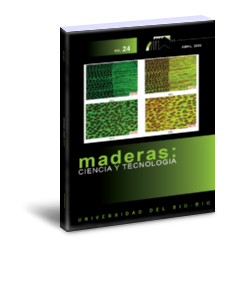Chemical constituents of palm wastes slow pyrolysis derived vinegar
DOI:
https://doi.org/10.4067/s0718-221x2022000100447Keywords:
GC analysis, GC/MS, palm wastes, slow pyrolysis, vinegarAbstract
Out of rachis and stem of palm tree from grooves in humid and dry zones, test materials were randomly collected and chipped for slow pyrolysis process. Chemical constituents of a set of pyrolysis derived vinegar were identified in their aqueous phase by gas chromatograph and quantitatively compared in sampled parts of sampled tree and grooves. Another set of vinegar was dewatered by dichloromethane, then their constituents were identified by gas chromatograph coupled with mass spectrometer, chemical constituents in aqueous state in both sampled grooves were the same but with different percentage values. In the organic phase, common chemical constituents of sampled parts and grooves were quantitatively compared. In humid zone rachis was 2,22 times richer in acetic acid and 2,37 times in phenol, but in dry zone stem is richer in acetic acid by 15,35 %. In their organic phases dominant and comparable chemicals of stem and rachis from sampled zone were furfural, phenol, benzic acid, 5-methyl-2- furancarboraldehyde, butanic acid and 2-methyl-phenol. Stem from dry zone was richer in these chemicals by 36,55 %, 96,93 %, 6,37 times, 62,05, 49, 32,57 % respectively. Rachis of humid zone contained more furfural, 63,95 %, 22,08 %, 2-methyl-phenol, but that of dry zone was richer in phenol by 46,20 %, 2,5 times in benzoic acid. Results from both phases of vinegar indicate that ecological impacts on the chemical constituents of palm from the same species are evident.
Downloads
References
Ahmadi, K.; Gholizadeh, H.; Ebadzadeh, H.R.; Hatami, F.; Fazli Starbagh, M.; Hossein Pur, R.; Kazemian, A.; Rafiei, M. 2015. Agricultural Statistics. Ministry of Agriculture of Iran, Tehran, 147pp. (In Persian).
Al-Wabel, M.I.; Usman, A.R.A.; Al-Farraj, A.S.; Ok, Y.S.; Abduljabbar, A.; Al-Faraj, A.I.; Sallam, A.S. 2019. Date palm waste biochars alter a soil respiration, microbial biomass carbon, and heavy metal mobility in contaminated mined soil. Environ Geochem Health 41(4): 1705-1722.
https://doi.org/10.1007/s10653-017-9955-0
Bensidhom, G.; Hassen-Trabelsi, A.B.; Alper, K.; Sghairoun, M.; Zaafouri, K.; Trabelsi, I. 2018. Pyrolysis of Date palm waste in a fixed-bed reactor: Characterization of pyrolytic products. Bioresour Technol 247: 363-369. https://doi.org/10.1016/j.biortech.2017.09.066
Hussain, A.; Farooq, A.; Bassyouni, M.I.; Sait, H.H.; El-Wafa, M.A.; Hasan, S.W.; Ani, F.N. 2014. Pyrolysis of Saudi Arabian date palm waste: A viable option for converting waste into wealth. Life Sci J 11(12): 667-671.https://doi.org/10.7537/marslsj111214.126
Jonoobi, M.; Shafie, M.; Shirmohammadli, Y.; Ashori, A.; Hosseinabadi, H.Z.; Mekonnen, T. 2019. A review on date palm tree: properties, characterization and its potential applications. J Renew Mater 7(11): 1055-1075.https://doi.org/10.32604/jrm.2019.08188
Jouiad, M.; Al-Nofeli, N.; Khalifa, N.; Benyettou, F.; Yousef, L.F. 2015. Characteristics of slow pyrolysis biochars produced from rhodes grass and fronds of edible date palm. J Anal Appl Pyrolysis 111: 183-190. https://doi.org/10.1016/j.jaap.2014.10.024
Kloss, S.; Zehetner, F.; Dellantonio, A.; Hamid, R.; Ottner, F.; Liedtke, V.; Schwanninger, M.; Gerzabek, M.H.; Soja, G. 2012. Characterization of slow pyrolysis biochars: effects of feedstocks and pyrolysis temperature on biochar properties. J Environ Qual 41(4): 990-1000. https://doi.org/10.2134/jeq2011.0070
Koc, I.; Yardim, E.N.; Akca, M.O.; Namli, A. 2018. Impact of pesticides and wood vinegar, used in wheat agro-ecosystems, on the soil enzyme activities. Fresenius Environ Bull 27(4): 2442-2448. https://www.cabdirect.org/cabdirect/abstract/20183205982
Li, Z.; Zhang, Z.; Wu, L.; Zhang, H.; Wang, Z. 2019. Characterization of five kinds of wood vinegar obtained from agricultural and forestry wastes and identification of major antioxidants in wood vinegar. Chem Res Chin Univ 35(1): 12-20.https://doi.org/10.1007/s40242-019-8207-5
Martin, C.; Northeim, C. 1996. Characterization of Manufacturing Processes and Emissions and Pollution Prevention Options for the Composite Wood Industry. US Environmental Protection Agency, Air Pollution Prevention and Control Division.
https://cfpub.epa.gov/si/si_public_record_Report.cfm?Lab=NRMRL&dirEntryId=115182
Oramahi, H.A.; Yoshimura, T.; Diba, F.; Setyawati, D. 2018. Antifungal and antitermitic activities of wood vinegar from oil palm trunk. J Wood Sci 64(3): 311-317. https://doi.org/10.1007/s10086-018-1703-2
Prasad, R.; Power, J.F. 1991. Crop residue management. In Advances in soil science, Volume 15. Springer, New York, NY, USA. 205-251.
https://doi.org/10.1007/978-1-4612-3030-4_5
Ronsse, F.; Van Hecke, S.; Dickinson, D.; Prins, W. 2013. Production and characterization of slow pyrolysis biochar: influence of feedstock type and pyrolysis conditions. GCB Bioenergy 5(2):104-115. https://doi.org/10.1111/gcbb.12018
Skjemstad, J.O.; Reicosky, D.C.; Wilts, A.R.; McGowan, J.A. 2002. Charcoal carbon in US agricultural soils. Soil Sci Soc Am J 66(4): 1249–1255.
http://dx.doi.org/10.2136/sssaj2002.1249
Tiilikkala, K.; Fagernäs, L.; Tiilikkala, J. 2010. History and Use of Wood Pyrolysis Liquids as Biocide and Plant Protection ProductHistory and Use of Wood Pyrolysis Liquids as Biocide and Plant Protection Product. Open Agric J 4(1): 111-118. https://doi.org/10.2174/1874331501004010111
Usman, A.; Sallam, A.; Zhang, M.; Vithanage, M.; Ahmad, M.; Al-Farraj, A.; Ok, Y.S.; Abduljabbar, A.; Al-Wabel, M. 2016. Sorption process of date palm biochar for aqueous Cd (II) removal: Efficiency and mechanisms. Water Air Soil Pollut 227(12):1-16. https://doi.org/10.1007/s11270-016-3161-z
Usman, A.R.; Abduljabbar, A.; Vithanage, M.; Ok, Y.S.; Ahmad, M.; Ahmad, M.; Elfaki, J.; Abdulazeem, S.S.; Al-Wabel, M.I. 2015. Biochar production from date palm waste: charring temperature induced changes in composition and surface chemistry. J Anal Appl Pyrolysis 115: 392-400. https://doi.org/10.1016/j.jaap.2015.08.016
Woolf, D.; Amonette, J.E.; Street-Perrott, F.A.; Lehmann, J.; Joseph, S. 2010. Sustainable biochar to mitigate global climate change. Nat Commun 1(1):1-9. https://doi.org/10.1038/ncomms1053
Yang, J.F.; Yang, C.H.; Liang, M.T.; Gao, Z.J.; Wu, Y.W., Chuang, L.Y. 2016. Chemical composition, antioxidant, and antibacterial activity of wood vinegar from Litchi chinensis. Molecules 21(9): 1150. https://doi.org/10.3390/molecules21091150
Downloads
Published
How to Cite
Issue
Section
License

This work is licensed under a Creative Commons Attribution 4.0 International License.
Los autores/as conservarán sus derechos de autor y garantizarán a la revista el derecho de primera publicación de su obra, el cuál estará simultáneamente sujeto a la Licencia de Reconocimiento de Creative Commons CC-BY que permite a terceros compartir la obra siempre que se indique su autor y su primera publicación esta revista.




































